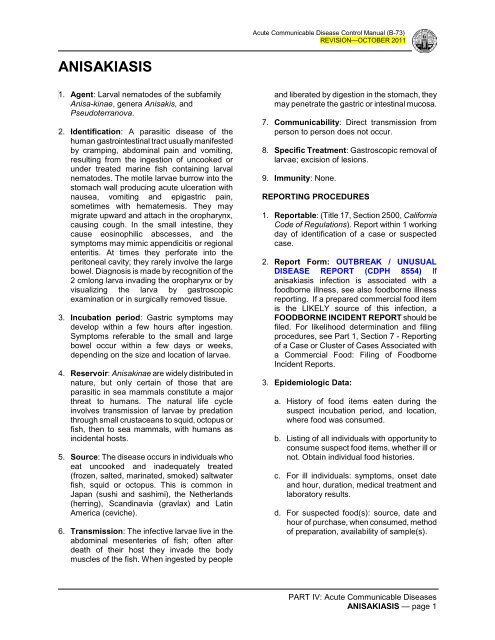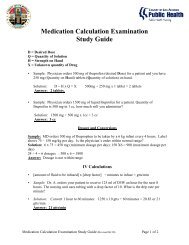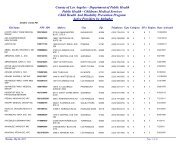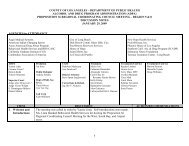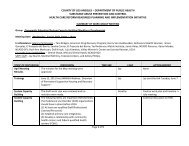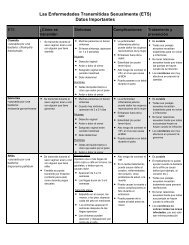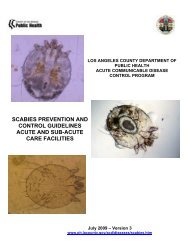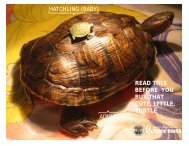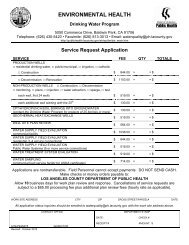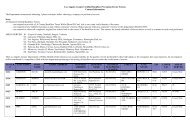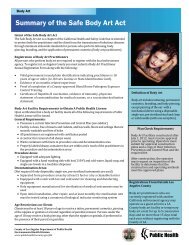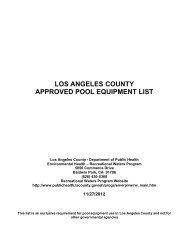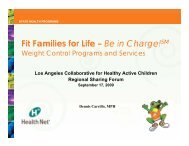ANISAKIASIS - Department of Public Health
ANISAKIASIS - Department of Public Health
ANISAKIASIS - Department of Public Health
Create successful ePaper yourself
Turn your PDF publications into a flip-book with our unique Google optimized e-Paper software.
Acute Communicable Disease Control Manual (B-73)<br />
REVISION—OCTOBER 2011<br />
<strong>ANISAKIASIS</strong><br />
1. Agent: Larval nematodes <strong>of</strong> the subfamily<br />
Anisa-kinae, genera Anisakis, and<br />
Pseudoterranova.<br />
2. Identification: A parasitic disease <strong>of</strong> the<br />
human gastrointestinal tract usually manifested<br />
by cramping, abdominal pain and vomiting,<br />
resulting from the ingestion <strong>of</strong> uncooked or<br />
under treated marine fish containing larval<br />
nematodes. The motile larvae burrow into the<br />
stomach wall producing acute ulceration with<br />
nausea, vomiting and epigastric pain,<br />
sometimes with hematemesis. They may<br />
migrate upward and attach in the oropharynx,<br />
causing cough. In the small intestine, they<br />
cause eosinophilic abscesses, and the<br />
symptoms may mimic appendicitis or regional<br />
enteritis. At times they perforate into the<br />
peritoneal cavity; they rarely involve the large<br />
bowel. Diagnosis is made by recognition <strong>of</strong> the<br />
2 cmlong larva invading the oropharynx or by<br />
visualizing the larva by gastroscopic<br />
examination or in surgically removed tissue.<br />
3. Incubation period: Gastric symptoms may<br />
develop within a few hours after ingestion.<br />
Symptoms referable to the small and large<br />
bowel occur within a few days or weeks,<br />
depending on the size and location <strong>of</strong> larvae.<br />
4. Reservoir: Anisakinae are widely distributed in<br />
nature, but only certain <strong>of</strong> those that are<br />
parasitic in sea mammals constitute a major<br />
threat to humans. The natural life cycle<br />
involves transmission <strong>of</strong> larvae by predation<br />
through small crustaceans to squid, octopus or<br />
fish, then to sea mammals, with humans as<br />
incidental hosts.<br />
5. Source: The disease occurs in individuals who<br />
eat uncooked and inadequately treated<br />
(frozen, salted, marinated, smoked) saltwater<br />
fish, squid or octopus. This is common in<br />
Japan (sushi and sashimi), the Netherlands<br />
(herring), Scandinavia (gravlax) and Latin<br />
America (ceviche).<br />
6. Transmission: The infective larvae live in the<br />
abdominal mesenteries <strong>of</strong> fish; <strong>of</strong>ten after<br />
death <strong>of</strong> their host they invade the body<br />
muscles <strong>of</strong> the fish. When ingested by people<br />
and liberated by digestion in the stomach, they<br />
may penetrate the gastric or intestinal mucosa.<br />
7. Communicability: Direct transmission from<br />
person to person does not occur.<br />
8. Specific Treatment: Gastroscopic removal <strong>of</strong><br />
larvae; excision <strong>of</strong> lesions.<br />
9. Immunity: None.<br />
REPORTING PROCEDURES<br />
1. Reportable: (Title 17, Section 2500, California<br />
Code <strong>of</strong> Regulations). Report within 1 working<br />
day <strong>of</strong> identification <strong>of</strong> a case or suspected<br />
case.<br />
2. Report Form: OUTBREAK / UNUSUAL<br />
DISEASE REPORT (CDPH 8554) If<br />
anisakiasis infection is associated with a<br />
foodborne illness, see also foodborne illness<br />
reporting. If a prepared commercial food item<br />
is the LIKELY source <strong>of</strong> this infection, a<br />
FOODBORNE INCIDENT REPORT should be<br />
filed. For likelihood determination and filing<br />
procedures, see Part 1, Section 7 - Reporting<br />
<strong>of</strong> a Case or Cluster <strong>of</strong> Cases Associated with<br />
a Commercial Food: Filing <strong>of</strong> Foodborne<br />
Incident Reports.<br />
3. Epidemiologic Data:<br />
a. History <strong>of</strong> food items eaten during the<br />
suspect incubation period, and location,<br />
where food was consumed.<br />
b. Listing <strong>of</strong> all individuals with opportunity to<br />
consume suspect food items, whether ill or<br />
not. Obtain individual food histories.<br />
c. For ill individuals: symptoms, onset date<br />
and hour, duration, medical treatment and<br />
laboratory results.<br />
d. For suspected food(s): source, date and<br />
hour <strong>of</strong> purchase, when consumed, method<br />
<strong>of</strong> preparation, availability <strong>of</strong> sample(s).<br />
PART IV: Acute Communicable Diseases<br />
<strong>ANISAKIASIS</strong> — page 1
Acute Communicable Disease Control Manual (B-73)<br />
REVISION—OCTOBER 2011<br />
CONTROL OF CASE, CONTACTS & CARRIERS<br />
CASE: No restrictions.<br />
CONTACTS: Examination <strong>of</strong> others possibly<br />
exposed at the same time may be productive.<br />
PREVENTION-EDUCATION<br />
1. Avoid ingestion <strong>of</strong> inadequately cooked marine<br />
fish. Heating to 60 "C (140 "F) for 10 minutes,<br />
blast-freezing to -35 "C (-31 "F) or below for 15<br />
hours or freezing by regular means at -23 "C<br />
(10 "F) for at least 7 days kills the larvae.<br />
Irradiation effectively kills the parasite.<br />
2. Cleaning (evisceration) <strong>of</strong> fish as soon as<br />
possible after they are caught reduces the<br />
number <strong>of</strong> larvae penetrating into the muscles<br />
from the mesenteries.<br />
DIAGNOSTIC PROCEDURES<br />
Consult <strong>Public</strong> <strong>Health</strong> Laboratory, Parasitology<br />
Section.<br />
PART IV: Acute Communicable Diseases<br />
<strong>ANISAKIASIS</strong> — page 2


